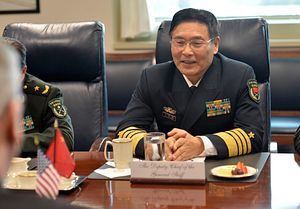On October 15, deputy chief of staff of the People’s Liberation Army (PLA), Admiral Sun Jianguo, met with Iranian Defense Minister Hossein Dehghan in Tehran to discuss deepening military cooperation between the two countries Reuters reports.
“The aim of this delegation’s visit is to further promote friendship, deepen cooperation and exchange views with Iran on bilateral military ties and issues of mutual concern,” the Chinese admiral said. The visit will furthermore “promote the preservation of international and regional peace and stability,” he added.
According to China Military Online, Admiral Sun Jianguo also met with his Iranian counterpart, chief of staff of the Iranian Armed Forces, Hassan Firouzabadi, discussing means to “deepen pragmatic cooperation in the military field and promote bilateral military relations to a higher level.”
China and Iran maintained close military-to-military contacts throughout the 1980s and 1990s. Among other things, China helped Iran boost its anti-access/area denial (A2/AD) capabilities by selling tactical ballistic and anti-ship cruise missiles (e.g., HY-2 “Silkworm” anti-ship missiles), advanced anti-ship mines, and Houdong fast-attack boats (equipped with anti-ship missiles) to the Islamic Republic.
China also provided technical expertise to Iran by, for example, helping develop Tehran’s indigenous Nasr anti-ship cruise missile. “Chinese design and technology can be seen in many Iranian missile series, from the short-range Oghab and Nazeat missiles to the long-range Shahab 3,” a 2012 RAND study explains.
Beijing moreover offered assistance to Iran’s nuclear program by training Iranian nuclear engineers and helped Iranian master uranium exploration and mining. Between 2000 and 2002, China also delivered a number of C-14 catamaran missile boats, but, as a Jamestown Foundation briefing notes, “the arms relationship essentially ended by 2005.”
Bilateral military-to-military ties continued to decline after 2005 until the early 2010s when a number of symbolic bilateral visits began to reverse the trend.
For example, in March 2013, the Iranian destroyer Sabalan and the helicopter carrier Kharg paid a port visit to Zhangjiagang port in Jiangsu province in China–a visit reciprocated in September 2014 by a visit of two People’s Liberation Army Navy (PLAN) ships, the destroyer Changchun and the frigate Changzhou, to the Iranian port of Bandar Abbas, located in the Strait of Hormuz.
In addition, in October 2014, a first ever visit of an Iranian Navy chief to China occurred discussing anti-piracy cooperation and humanitarian assistance/disaster relief operations among other things.
Thus, the recent visit of Admiral Sun Jianguo has to be put into this wider context of improving Sino-Iranian bilateral military-to-military cooperation. For now, these re-emerging ties still appear to be limited to symbolic gestures and talk. However, since both countries boast significant A2/AD capabilities, any exchanges of military know-how could pose risks for the U.S. military and will, in all likelihood, be watched very carefully by the Pentagon.

































